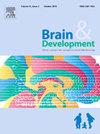Epilepsy phenotypes and responses to antiseizure medications in pediatric patients with EEF1A2-related epilepsy
IF 1.3
4区 医学
Q4 CLINICAL NEUROLOGY
引用次数: 0
Abstract
Objective
To delineate the epilepsy spectrum and evaluate the response of pediatric patients with EEF1A2-related epilepsy to antiseizure medications (ASMs).
Methods
We conducted a retrospective analysis of seven pediatric patients with EEF1A2 mutations identified at our institution, combined with 69 cases from prior literature, resulting in a cohort of 76 patients. Data for age of seizure onset, seizure types, epilepsy syndromes, ASM responses, and neurodevelopmental outcomes were collected and analyzed. Epilepsy syndromes were classified following the International League Against Epilepsy guideline.
Results
Among the 76 patients, 61 (80 %) presented with epilepsy, with a median seizure onset age of 4.5 months. Of these, 56 % experienced seizure onset before the age of 12 months. Generalized seizures were predominant (67 %), including epileptic spasms, myoclonic, tonic, and tonic-clonic seizures. Developmental epileptic encephalopathy (DEE) was observed in 59 % of patients, although a range of milder epilepsy phenotypes was also present. Broad-spectrum ASMs, such as valproic acid, lamotrigine, and levetiracetam, demonstrated effectiveness in controlling seizures in 65 % of patients. Recurrent mutations such as p.Gly70Ser and p. Glu122Lys were predominantly associated with severe DEE.
Conclusions
EEF1A2-related epilepsy encompasses a broad spectrum of phenotypes, from early-onset severe syndromes to milder forms. Specific mutations within EEF1A2 seemed to be correlated with severe DEE.
eef1a2相关癫痫患儿的癫痫表型和抗癫痫药物反应
目的描述小儿eef1a2相关性癫痫患者的癫痫谱,并评价其对抗癫痫药物的反应。方法:我们对我院发现的7例EEF1A2突变儿童患者进行回顾性分析,并结合既往文献中的69例病例,共76例患者。收集和分析癫痫发作年龄、发作类型、癫痫综合征、ASM反应和神经发育结局等数据。癫痫综合征按照国际抗癫痫联盟指南进行分类。结果76例患者中,61例(80%)出现癫痫,中位癫痫发作年龄为4.5个月。其中,56%的儿童在12个月前癫痫发作。全身性癫痫发作占主导地位(67%),包括癫痫性痉挛、肌阵挛性、强直性和强直-阵挛性发作。在59%的患者中观察到发展性癫痫性脑病(DEE),尽管也存在一系列较轻的癫痫表型。广谱抗痉挛药物,如丙戊酸、拉莫三嗪和左乙拉西坦,在65%的患者中显示出控制癫痫发作的有效性。p. gly70ser和p. Glu122Lys等复发性突变主要与严重的DEE相关。结论:seef1a2相关癫痫包括广泛的表型,从早发性严重综合征到较轻的形式。EEF1A2内的特定突变似乎与严重的DEE相关。
本文章由计算机程序翻译,如有差异,请以英文原文为准。
求助全文
约1分钟内获得全文
求助全文
来源期刊

Brain & Development
医学-临床神经学
CiteScore
3.60
自引率
0.00%
发文量
153
审稿时长
50 days
期刊介绍:
Brain and Development (ISSN 0387-7604) is the Official Journal of the Japanese Society of Child Neurology, and is aimed to promote clinical child neurology and developmental neuroscience.
The journal is devoted to publishing Review Articles, Full Length Original Papers, Case Reports and Letters to the Editor in the field of Child Neurology and related sciences. Proceedings of meetings, and professional announcements will be published at the Editor''s discretion. Letters concerning articles published in Brain and Development and other relevant issues are also welcome.
 求助内容:
求助内容: 应助结果提醒方式:
应助结果提醒方式:


